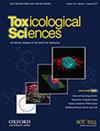Urinary bladder carcinogenic potential of 4,4’-methylenebis(2-chloroaniline) in humanized-liver mice
IF 3.4
3区 医学
Q2 TOXICOLOGY
引用次数: 0
Abstract
Occupational exposure to 4,4’-methylenebis(2-chloroaniline) (MOCA) has been linked to an increased risk of bladder cancer among employees in Japanese plants, indicating its significance as a risk factor for urinary bladder cancer. To investigate the role of MOCA metabolism in bladder carcinogenesis, we administered MOCA to non-humanized (F1-TKm30 mice) and humanized-liver mice for 4 and 28 weeks. We compared MOCA-induced changes in metabolic enzyme expression, metabolite formation, and effects on the urinary bladder epithelium in the two models. At week 4, MOCA exposure induced simple hyperplasia, cell proliferation, and DNA damage in the urothelium of the humanized-liver mice, while in the non-humanized mice these effects were not observed. Notably, the concentration of 4-amino-4'-hydroxylamino-3,3'-dichlorodiphenylmethane (N-OH-MOCA) in the urine of humanized-liver mice was more than 10 times higher than that in non-humanized mice at the 4-week mark. Additionally, we observed distinct differences in the expression of cytochrome P450 isoforms between the two models. Although no bladder tumors were detected after 28 weeks of treatment in either group, these findings suggest that N-OH-MOCA significantly contributes to the carcinogenic potential of MOCA in humans.4,4'-亚甲基双(2-氯苯胺)在人肝小鼠膀胱中的致癌潜力
在日本工厂工作的员工中,职业暴露于 4,4'-亚甲基双(2-氯苯胺)(MOCA)与膀胱癌风险增加有关,这表明它是膀胱癌的一个重要风险因素。为了研究 MOCA 代谢在膀胱癌发生中的作用,我们给非人化小鼠(F1-TKm30 小鼠)和人化肝脏小鼠注射了 4 周和 28 周的 MOCA。我们比较了两种模型中 MOCA 诱导的代谢酶表达变化、代谢物形成以及对膀胱上皮的影响。接触 MOCA 第 4 周时,人源化肝脏小鼠的尿路上皮细胞出现了单纯性增生、细胞增殖和 DNA 损伤,而非人源化小鼠则未观察到这些影响。值得注意的是,人源化肝脏小鼠尿液中的 4-氨基-4'-羟基氨基-3,3'-二氯二苯甲烷(N-OH-MOCA)浓度在 4 周时是非人源化小鼠的 10 倍以上。此外,我们还观察到两种模型的细胞色素 P450 同工酶的表达存在明显差异。虽然两组小鼠在治疗 28 周后都没有发现膀胱肿瘤,但这些发现表明,N-OH-MOCA 在很大程度上增加了 MOCA 对人类的致癌性。
本文章由计算机程序翻译,如有差异,请以英文原文为准。
求助全文
约1分钟内获得全文
求助全文
来源期刊

Toxicological Sciences
医学-毒理学
CiteScore
7.70
自引率
7.90%
发文量
118
审稿时长
1.5 months
期刊介绍:
The mission of Toxicological Sciences, the official journal of the Society of Toxicology, is to publish a broad spectrum of impactful research in the field of toxicology.
The primary focus of Toxicological Sciences is on original research articles. The journal also provides expert insight via contemporary and systematic reviews, as well as forum articles and editorial content that addresses important topics in the field.
The scope of Toxicological Sciences is focused on a broad spectrum of impactful toxicological research that will advance the multidisciplinary field of toxicology ranging from basic research to model development and application, and decision making. Submissions will include diverse technologies and approaches including, but not limited to: bioinformatics and computational biology, biochemistry, exposure science, histopathology, mass spectrometry, molecular biology, population-based sciences, tissue and cell-based systems, and whole-animal studies. Integrative approaches that combine realistic exposure scenarios with impactful analyses that move the field forward are encouraged.
 求助内容:
求助内容: 应助结果提醒方式:
应助结果提醒方式:


